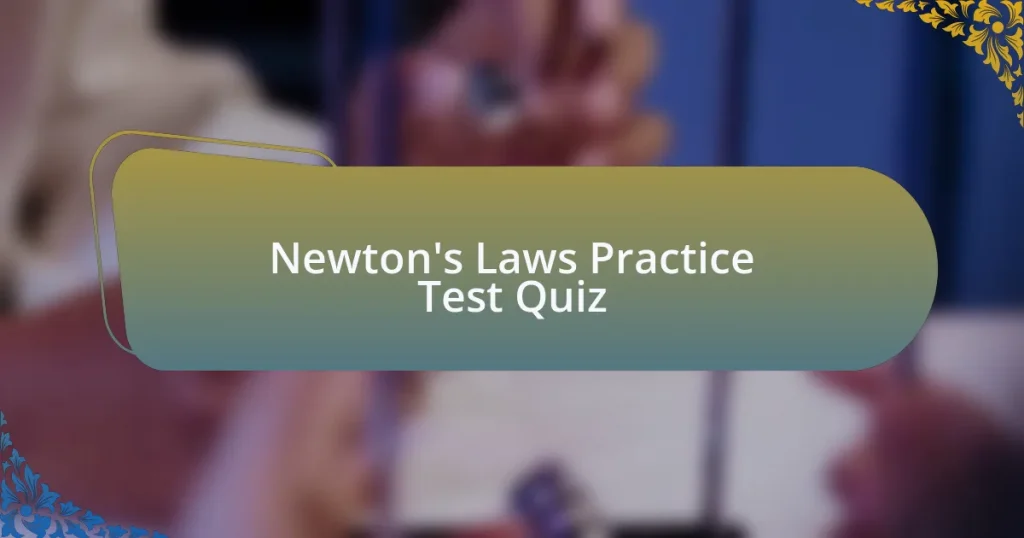Start of Newton’s Laws Practice Test Quiz
1. What does Newton’s first law of motion state?
- An object at rest stays at rest and an object in motion stays in motion with the same speed and in the same direction unless acted upon by an unbalanced force.
- An object in motion tends to speed up indefinitely without any forces acting on it.
- An object at rest can only move if a force is applied continuously.
- An object will stop moving if no force is applied within a certain time frame.
2. According to Newton’s second law, how is acceleration determined by net force and mass?
- The acceleration of an object as produced by a net force is directly proportional to the magnitude of the net force, in the same direction as the net force, and inversely proportional to the mass of the object.
- Acceleration is determined only by an object`s speed, not mass or force.
- An object`s acceleration is independent of both net force and mass.
- The acceleration of an object decreases as mass increases, regardless of net force.
3. Can you explain Newton’s third law of motion?
- For every action there is an equal and opposite reaction.
- The acceleration of an object increases as its mass decreases.
- The force of an object will always be greater than the force applied to it.
- An object at rest will remain at rest until a force acts on it.
4. What real-life example illustrates Newton’s third law when a climber pulls on a rope?
- The climber stays still while pulling the rope.
- The climber slides sideways while pulling the rope.
- The climber falls down as he pulls the rope up.
- The climber lifts upward as he pulls the rope down.
5. How would you express the relationship defined by Newton’s second law mathematically?
- ACCELERATION = FORCE / MASS
- FORCE = ACCELERATION / MASS
- FORCE = MASS times ACCELERATION
- FORCE + MASS = ACCELERATION
6. Describe an example that demonstrates Newton’s third law involving bumper cars.
- Bumper cars spin around without changing their position after a late hit.
- A bumper car accelerates forward without any interaction with others.
- Two bumper cars collide into each other, and each car jolts backwards.
- One bumper car crashes into a wall and doesn’t move back.
7. How does adding more weight affect the acceleration of a cyclist?
- The acceleration increases.
- The acceleration becomes negative.
- The acceleration decreases.
- The acceleration remains the same.
8. Give an example of Newton’s third law demonstrated by a simple action.
- A ball rolls down a hill due to gravity.
- A rocket expels gas to move in the opposite direction.
- A car accelerates when the driver steps on the gas.
- A swimmer pushes the water backward to propel herself forward.
9. What observation can be made when a smaller cannonball is fired compared to a larger one?
- The larger cannonball travels faster than the smaller one.
- The smaller cannonball does not leave the cannon.
- Both cannonballs travel at the same speed.
- The smaller cannonball travels faster than the larger one.
10. In what situation do you experience Newton’s first law while on a subway?
- When the subway train is moving smoothly and you feel nothing.
- When the subway train suddenly stops and your body continues to move forward.
- When the subway train speeds up and you feel a push backward.
- When the subway train makes a turn and you slide to the side.
11. How does the weight of your backpack relate to Newton’s first law?
- The weight of your backpack increases your speed when running.
- Heavier backpacks weigh down on the ground, not on your motion.
- The weight of your backpack has no impact on your ability to carry it.
- The weight of your backpack affects its inertia, making it harder to move or stop.
12. Explain how friction affects a boy sliding down a slide based on Newton’s first law.
- Friction causes the boy to accelerate faster down the slide.
- Friction keeps the boy in a state of uniform motion down the slide.
- Friction has no effect on the boy as he slides down the slide.
- Friction acts as an unbalanced force that slows down the boy as he slides down the slide.
13. What is the definition of inertia in the context of physics?
- The natural tendency of objects to resist changes in their state of motion.
- The speed at which an object moves in a straight line.
- The measure of how much matter is in an object.
- The force that an object exerts on another object during a collision.
14. How does the mass of an object influence its inertia?
- Heavier objects have less inertia than lighter ones.
- Mass has no effect on inertia.
- The more the mass, the more the inertia.
- Inertia increases only with speed, not mass.
15. What effect does mass have on the acceleration of an object?
- Mass does not affect acceleration at all.
- All objects accelerate equally regardless of mass.
- A smaller mass accelerates faster than a larger mass.
- A larger mass always moves faster than a smaller mass.
16. What unit is used to measure mass?
- Joule
- Meter
- Kilogram
- Newton
17. Which unit is designated for measuring force?
- Watt
- Joule
- Newton
- Pascal
18. What unit is used for measuring acceleration?
- J
- kg
- m/s²
- N
19. Can you relate Newton`s second law with the equation 1N = 1kg * m/S²?
- No
- Yes
- Maybe
- Uncertain
20. Is the commonly accepted acceleration due to gravity always 9.8 m/s²?
- 10 m/s²
- No
- 9.0 m/s²
- Yes
21. What equations describe the relationship between force, mass, and acceleration?
- F=ma²
- F=mxa
- a=F/m²
- m=F/a²
22. Calculate the acceleration of a block when a force of 52 N is applied to a 4 kg block.
- 8 m/S2
- 10 m/S2
- 15 m/S2
- 13 m/S2
23. What is the acceleration if a 5 kg block is pulled with a force of 61 N?
- 10.2 m/S2
- 12.2 m/S2
- 9.0 m/S2
- 15.0 m/S2
24. Determine the acceleration of a 25 kg person pushed upward with 300 N.
- 6 m/S2
- 10 m/S2
- 8 m/S2
- 12 m/S2
25. What force is needed to accelerate a 10 kg object upwards at 2 m/s²?
- 10 N
- 30 N
- 50 N
- 20 N
26. How do you find the mass of an object if a force of 17 N causes it to accelerate at 1.5 m/s²?
- 8.0 Kg
- 11.3 Kg
- 15.0 Kg
- 12.5 Kg
27. What is the acceleration of a 10 kg object acted upon by a 3 N force?
- 0.5 m/S2
- 0.3 m/S2
- 0.9 m/S2
- 1.0 m/S2
28. What mass is required for a force of 25 N to produce an acceleration of 5 m/s²?
- 5 Kg
- 15 Kg
- 2 Kg
- 10 Kg
29. Calculate the acceleration given a force of 5.20 N on a 1.05-kg object.
- 5.5 m/S2
- 1.25 m/S2
- 4.95 m/S2
- 3.33 m/S2
30. What is the acceleration of a 72 kg skydiver experiencing a 540 N air resistance?
- 0.5 m/S2
- 10 m/S2
- 6.0 m/S2
- 7.5 m/S2
Congratulations! You’ve Completed the Newton’s Laws Practice Test
Well done on finishing the quiz on Newton’s Laws! This exercise not only tests your understanding but also reinforces crucial concepts in physics. You have explored the fundamental principles that govern motion and forces. Remember, these laws help us explain everything from a falling apple to the flight of rockets.
As you navigated through the questions, you likely discovered areas that expanded your critical thinking and analytical skills. Newton’s laws are not just theoretical; they apply to real-world scenarios. Understanding how objects behave under various forces prepares you for further studies and everyday situations.
If you enjoyed this practice test and want to deepen your knowledge even further, we invite you to explore the next section on this page. Here, you’ll find more detailed information about Newton’s Laws. This valuable resource will enhance your understanding and help you excel in your physics test preparation. Keep up the great work!
Newton’s Laws Practice Test
Understanding Newton’s Laws of Motion
Newton’s Laws of Motion consist of three fundamental principles that describe the relationship between an object and the forces acting on it. The first law, often called the law of inertia, states that an object at rest will remain at rest, and an object in motion will continue in its motion unless acted upon by a net external force. The second law quantifies the effect of force on an object’s motion, expressed as F=ma, where F is net force, m is mass, and a is acceleration. The third law asserts that for every action, there is an equal and opposite reaction. These laws form the foundation of classical mechanics.
The Format of a Newton’s Laws Practice Test
A Newton’s Laws Practice Test typically consists of multiple-choice questions, true/false statements, and problem-solving exercises that apply the laws in various scenarios. Questions can range from conceptual understanding to numerical problems requiring calculations of force, mass, and acceleration. The format aims to assess both theoretical knowledge and practical application, helping students gauge their understanding of the laws.
Common Types of Questions on Newton’s Laws Practice Test
Common question types in a Newton’s Laws Practice Test include identifying the correct law based on a scenario, calculating forces using F=ma, and analyzing motion graphs. Students might be asked to determine the net force acting on an object or to predict the motion of an object based on its mass and applied forces. These questions assess comprehension and analytical skills.
Tips for Success on Newton’s Laws Practice Tests
To excel in Newton’s Laws Practice Tests, students should review examples that illustrate each law in action. Practicing problem-solving with a focus on units and conversions is crucial. Understanding free-body diagrams can aid in visualizing forces acting on objects. Regular practice with timed quizzes helps improve speed and accuracy while familiarizing students with the test format.
Resources for Preparing for Newton’s Laws Practice Tests
Various resources are available for students preparing for Newton’s Laws Practice Tests. Textbooks offer theoretical explanations and example problems. Online platforms provide interactive quizzes and simulations to visualize concepts. Video tutorials often clarify difficult topics through demonstrations. Additionally, past exam papers can serve as valuable practice tools to understand the test structure and question types.
What is a Newton’s Laws Practice Test?
A Newton’s Laws Practice Test is an assessment designed to evaluate a student’s understanding of Sir Isaac Newton’s three laws of motion. These laws describe how objects move in response to forces acting upon them. The test typically includes multiple-choice questions, problem-solving exercises, and conceptual questions related to the laws. It serves as an effective tool for physics test preparation, allowing students to reinforce their knowledge through targeted practice.
How can I prepare for a Newton’s Laws Practice Test?
To prepare for a Newton’s Laws Practice Test, students should review the fundamental concepts of each law and solve practice problems relevant to those laws. Resources such as textbooks, online courses, and educational videos can aid in understanding. Additionally, completing sample tests and seeking help on challenging problems will enhance students’ problem-solving skills. Regular practice will reinforce their understanding and prepare them for the actual test.
Where can I find resources for Newton’s Laws Practice Tests?
Resources for Newton’s Laws Practice Tests are available in various formats. Educational websites offer free and paid practice tests, while online learning platforms like Khan Academy and Coursera provide structured lessons and quizzes. Libraries and bookstores have textbooks specifically geared towards physics test preparation. Using a combination of these resources will ensure comprehensive coverage of the topic.
When should I take a Newton’s Laws Practice Test?
A Newton’s Laws Practice Test should ideally be taken after studying the three laws of motion and related concepts. It is beneficial to take the test a few days before the actual exam to assess understanding and identify areas that require further review. This timing allows for additional study and helps solidify knowledge just before the formal assessment.
Who should take a Newton’s Laws Practice Test?
Students enrolled in physics courses, particularly those studying mechanics, should take a Newton’s Laws Practice Test. This includes high school students preparing for AP Physics exams and college students in introductory physics courses. Anyone seeking to improve their understanding of motion and forces can benefit from this practice, regardless of their current proficiency level.















